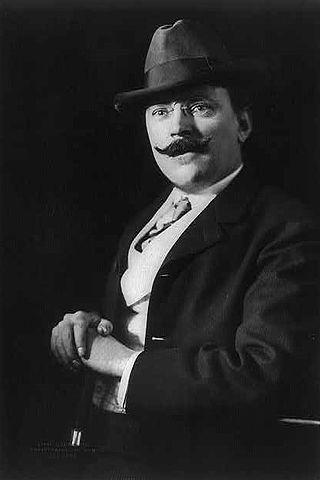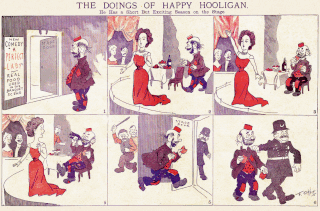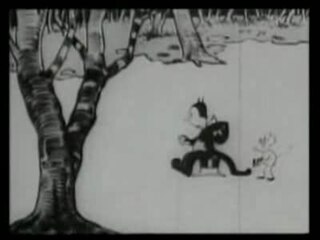
Alphons is a male given name recorded from the 8th century in the Christian successor states of the Visigothic kingdom in the Iberian peninsula. In the later medieval period it became a standard name in the Hispanic and Portuguese royal families.

The Katzenjammer Kids is an American comic strip created by Rudolph Dirks in 1897 and later drawn by Harold Knerr for 35 years. It debuted on December 12, 1897, in the American Humorist, the Sunday supplement of William Randolph Hearst's New York Journal. The comic strip was turned into a stage play in 1903. It inspired several animated cartoons and was one of 20 strips included in the Comic Strip Classics series of U.S. commemorative postage stamps.

"Who's on First?" is a comedy routine made famous by American comedy duo Abbott and Costello. The premise of the sketch is that Abbott is identifying the players on a baseball team for Costello. However, the players' names can simultaneously serve as the basis for questions and responses, leading to reciprocal misunderstanding and growing frustration between the performers. Although it is commonly known as "Who's on First?", Abbott and Costello frequently referred to it simply as "Baseball".

Ribaldry or blue comedy is humorous entertainment that ranges from bordering on indelicacy to indecency. Blue comedy is also referred to as "bawdiness" or being "bawdy". Like any humour, ribaldry may be read as conventional or subversive. Ribaldry typically depends on a shared background of sexual conventions and values, and its comedy generally depends on seeing those conventions broken.

Richard Felton Outcault was an American cartoonist. He was the creator of the series The Yellow Kid and Buster Brown and is considered a key pioneer of the modern comic strip.
Alphonse is the French variant of the given name Alfonso. People called Alphonse include:

Buster Brown is a comic-strip character created in 1902 by Richard F. Outcault. Adopted as the mascot of the Brown Shoe Company in 1904, Buster Brown, along with Mary Jane, and with his dog Tige, became well known to the American public in the early 20th century. The character's name was used to describe a popular style of suit for young boys, the Buster Brown suit, that reflected his outfit.

Frederick Burr Opper was one of the pioneers of American newspaper comic strips, best known for his comic strip Happy Hooligan. His comic characters were featured in magazine gag cartoons, covers, political cartoons and comic strips for six decades.

King Features Syndicate, Inc. is an American content distribution and animation studio, consumer product licensing and print syndication company owned by Hearst Communications that distributes about 150 comic strips, newspaper columns, editorial cartoons, puzzles, and games to nearly 5,000 newspapers worldwide. King Features Syndicate also produces intellectual properties, develops new content and franchises, like The Cuphead Show!, which it produced with Netflix, and licenses its classic characters and properties.

Harry Hershfield was an American cartoonist, humor writer and radio personality. He was known as "the Jewish Will Rogers". Hershfield also was a columnist for the New York Daily Mirror. His books include Laugh Louder, Live Longer and Now I'll Tell One. As a comics artist he is best remembered for his newspaper comic Abie the Agent.
Notable events of 1937 in comics.

And Her Name Was Maud is a comic strip by Frederick Burr Opper. It first appeared in the Hearst newspapers on July 24, 1904. After work as a magazine cartoonist, Opper was hired by Hearst in 1899 to draw comic strips for the New York Journal, launching Happy Hooligan, Alphonse and Gaston and And Her Name Was Maud.

Gigot is a 1962 American comedy-drama film directed by Gene Kelly and starring Jackie Gleason.
United States v. One Book Called Ulysses, 5 F. Supp. 182, is a landmark decision by the United States District Court for the Southern District of New York in a case dealing with freedom of expression. At issue was whether James Joyce's 1922 novel Ulysses was obscene. In deciding it was not, Judge John M. Woolsey opened the door to importation and publication of serious works of literature that used coarse language or involved sexual subjects.

Happy Hooligan is an American comic strip, the first major strip by the already celebrated cartoonist Frederick Burr Opper. It debuted with a Sunday strip on March 11, 1900 in the William Randolph Hearst newspapers, and was one of the first popular comics with King Features Syndicate. The strip ran for three decades, ending on August 14, 1932.
This is a timeline of significant events in comics in the 1900s.
Tax protesters in the United States advance a number of constitutional arguments asserting that the imposition, assessment and collection of the federal income tax violates the United States Constitution. These kinds of arguments, though related to, are distinguished from statutory and administrative arguments, which presuppose the constitutionality of the income tax, as well as from general conspiracy arguments, which are based upon the proposition that the three branches of the federal government are involved together in a deliberate, on-going campaign of deception for the purpose of defrauding individuals or entities of their wealth or profits. Although constitutional challenges to U.S. tax laws are frequently directed towards the validity and effect of the Sixteenth Amendment, assertions that the income tax violates various other provisions of the Constitution have been made as well.

Thomas Starling Sullivant was an American cartoonist who signed his work T. S. Sullivant. His work appeared most frequently in the pages of the humorous Life magazine. Best known for his animal and ethnic caricatures, he also drew political cartoons and comic strip toppers, and illustrated children's books. He drew in a heavily cross-hatched pen-and-ink style, with humans and animals depicted with greatly exaggerated features that are nevertheless firmly rooted in his understanding of correct anatomy.

The Hearst-Vitagraph News Pictorial or Hearst-Vita graph was a short-lived company producing newsreels which were coupled with animated cartoons. It was established on 29 October 1915 by the Brooklyn-based Vitagraph Studios and the Hearst Corporation, and produced its first reel in February 1916, but folded in 1916. Previously, Hearst had produced newsreels together with the Selig Polyscope Company from 1914 on, and after the deal with Vitagraph ended Hearst teamed up with Pathé.
The Vicinage Clause is a provision in the Sixth Amendment to the United States Constitution regulating the vicinity from which a jury pool may be selected. The clause says that the accused shall be entitled to an "impartial jury of the State and district wherein the crime shall have been committed, which district shall have been previously ascertained by law". The Vicinage Clause limits the vicinity of criminal jury selection to both the state and the federal judicial district where the crime has been committed. This is distinct from the venue provision of Article Three of the United States Constitution, which regulates the location of the actual trial.














